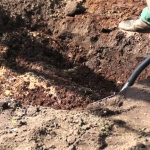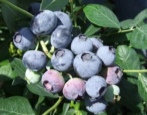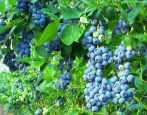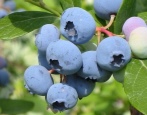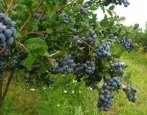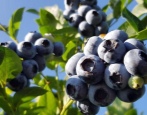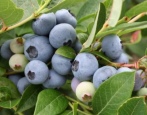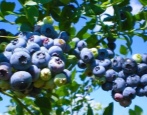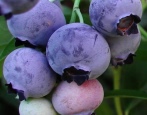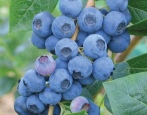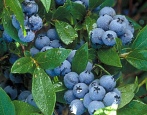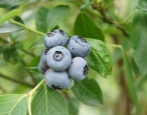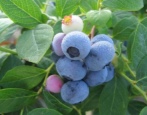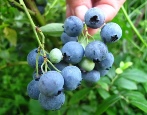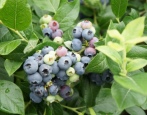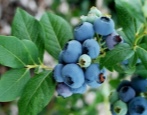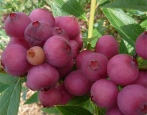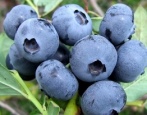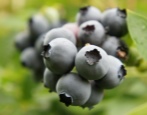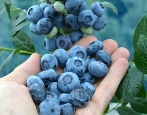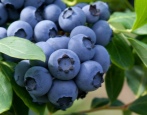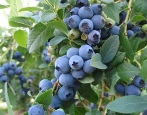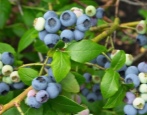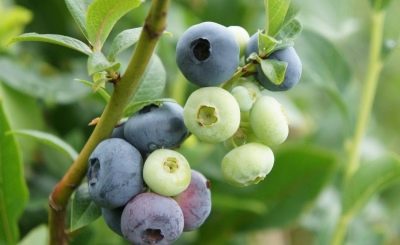
- Authors: USA
- Ripening terms: mid-season
- Growth type: tall
- Bush height, m: 1,2-1,8
- Taste: sweet
- Yield: high
- Average yield: 5-7 kg per bush
- Fruit size: large
- Fruit shape: slightly flat
- Fruit color: light blue
Blueberry Patriot is a high-yielding unpretentious crop that has high decorative performance and is used to create landscape compositions. Despite its undemanding care, the plant forms tasty, sweet and aromatic fruits for universal use. Berries can not only be eaten fresh, but can also be preserved, frozen and used to make healthy desserts.
Description of the variety
Blueberry Patriot (Patriot) - the result of painstaking selection work of US agronomists, which was completed with a positive result in 1976. To obtain a high-yielding culture, practical breeders took the following varieties as a basis:
Erliblu;
Dixie;
Michigan.
The initial purpose of the plant is landscape and decorative. However, later the variety also acquired a culinary direction. Berries are in demand both among connoisseurs of fresh fruits and among lovers of canned products. An adult healthy plant is capable of forming an average of 7 kg of juicy fruits, which have a high level of keeping quality and transportability.
Long-term breeding work has led to the fact that the cultivated culture has become not only unpretentious in care, but also resistant to temperature fluctuations and to the most common diseases. It attracts many gardeners with its decorative qualities.
The height of the central stem of the plant often reaches 1.8 meters. The bush consists of straight branches that do not thicken the open and spreading crown. The deciduous mass is ovoid. The color of the leaves ranges from red to green, depending on their age. The snow-white inflorescences of the plant have an unusual dome-shaped shape with velvet edges.
Advantages:
the formation of a large number of fruits;
high taste indicators;
unpretentiousness;
resistance to low temperatures;
unpretentiousness to watering;
low susceptibility to diseases and pests;
high level of keeping quality and transportability of fruits;
the absence of ripe berries subjected to crumbling;
the ability to use in landscape design.
Disadvantages:
the need for regular sanitary and corrective pruning;
reduction in fruit size in old plants;
exactingness to the ground.
Fruit characteristics
The high-yielding plant forms large fruits of a pale blue color with a pronounced matte shade. Blueberry color varies with maturity and can be green, red and blue. The berries are slightly flat and form dense clusters. The diameter of the ripe fruit is 19 mm. The green and dense fleshy structure is juicy and aromatic.
Taste qualities
The excellent taste of the fruits of this variety receive positive reviews even from the most demanding gourmets. Ripe juicy berries have a pleasant aroma and sweet taste. High taste characteristics allow the harvested crop to be used both for fresh consumption and for preparing tasty and healthy desserts and canning.
Ripening and fruiting
Blueberry Patriot has an extended flowering period, which begins in mid-May and lasts until the first days of July. The technical ripeness of the fruits begins in the last days of July. The ripe crop is not subject to shedding and spoilage, which significantly increases its presentation.
Yield
Blueberry Patriot is a high-yielding crop. Under favorable climatic conditions, one adult plant is able to form more than 8 kg of fruits. To obtain a healthy and strong plant, the fruits of the first harvest must be removed at the flowering stage, since young seedlings are not able to give a full harvest and may die.
Self-fertility and the need for pollinators
This crop belongs to self-pollinated plants, but in order to increase the amount of yield, breeders-practitioners recommend planting pollinating plants nearby, in which flowering occurs in one period.
Growing and care
Growing an unpretentious plant will not cause difficulties even for novice gardeners. The optimal timing for planting young shoots is in early spring and autumn. The selected site for planting should be sunny and as protected as possible from strong currents of cold winds. The diameter of the planting pit should be about 60 cm. For planting, it is better to choose a mixture of soil, sand, tree bark and sawdust. To alkalize the soil, it is imperative to add mineral fertilizers.
Particular attention should be paid to seedlings, which must have a strong root system and the absence of signs of fungal diseases. Dried root branches must be removed and treated with disinfectants.
After deepening the plant and compacting the soil, the young shoot must be fixed to a vertical support to prevent deformation of the trunk. The planted bush must be watered abundantly and the entire root zone must be mulched with bark or needles. The optimal distance between several plants is 100 cm.
To obtain large and juicy fruits, green spaces must be watered 1-2 times a week, depending on the general temperature regime. We should not forget about the timely introduction of mineral and organic fertilizers, which will significantly increase the resistance of the bushes to diseases and pests.
Given the rapid growth of the crown, the bushes need regular pruning starting from the 4th year of life.
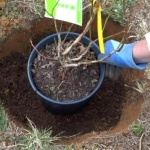

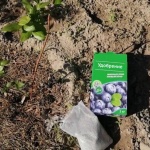
Disease and pest resistance
The unpretentious variety has a high level of immune response to most diseases and pests. However, in order to prevent the appearance of diseases such as late blight and root rot, breeders-practitioners recommend that regular preventive treatments with special preparations be carried out. Ignoring this recommendation can lead to crop damage or death of green spaces.
Experienced agronomists recommend not to forget about protecting plants from birds who like to feast on sweet berries.To scare away birds, it is advisable to install special scarecrows on the site and fence the plants with special nets.
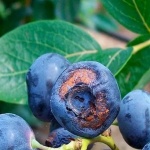
Winter hardiness and the need for shelter
Blueberry Patriot is a winter-hardy plant that can withstand temperatures as low as -30 degrees. However, young and fragile shoots before the onset of cold weather must be covered with spruce branches or a special covering material that will help prevent freezing of green spaces and damage to trunks by rodents.
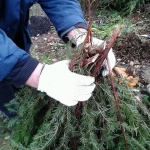
Location and soil requirements
To obtain healthy plants and a decent amount of yield, the selected plant area must be well lit. Drafts can reduce the volume and quality of the crop, so the place for growing blueberries must be protected from cold winds. The soil for growing blueberries must be acidified and moist. The plant feels comfortable both on loamy and sandy loamy soils.
